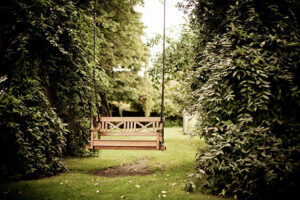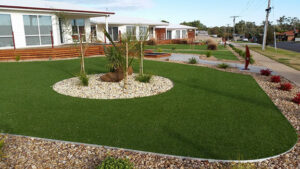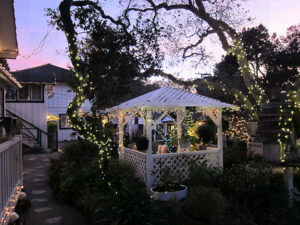So, you’d rather scale walls than build a retaining wall, and you avoid falling into water obstacles at all costs – that doesn’t mean you can’t create the perfect garden.
Even if you have never pulled out a weed in your life, our garden hacks can have you looking like a green thumb all year-round… And in doing so, help you free up time and space for ninja training!
Remember: planning beforehand saves on time, replacement plants and money.
Walk around your suburb and see what grows well without too much effort. If it grows on a local nature strip, it will grow in your garden!
Be realistic. If you would prefer to do nothing beyond watering, mowing and the occasional pulling up of weeds, don’t plant shrubs or vines that need trimming, or deciduous trees whose falling flowers or leaves will need raking.
Measure your space and sketch out your plans before shopping for plants. To create a green oasis, use different heights of plants with the tallest at the back. Use low maintenance hedging or spreading trees to define the ‘walls’ of your space. Or you could set up a low maintenance green wall system. See your local garden centre for recommendations.
Plan to have a focal point in the garden, such as a tree, wall art, fountain or even a fire pit. Note: a shed is not an ideal focal point!

If you are installing a fire pit, make sure it is on level ground and at least 4m away from flammable materials, such as buildings, fences, plants and overhanging trees. Also consider where the smoke might blow. Check with your local council for any restrictions.
Keep your garden beds narrow (less than 1m deep) and install edging. Any upkeep you need to do – such as reaching for the odd weed or sweeping adjacent paths – will be easy and quick.
Add hard surfaces, such as paved paths and pebble borders. As well as adding visual interest, they’ll reduce the area you need to water and tend.
Paved paths have a tendency to move over time. A quick and lasting solution to this is to install a durable and purpose-designed border system, such as aluminium edging, when laying the pavers. This also eliminates the need for ugly concrete to stabilise the pavers.
Repetition of simple details can give a sense of order and perfection. This could be as easy as repeating a well-defined mondo grass and pebble border throughout the garden.
Invest time in the front end of the project. Remove all weeds and dig in compost as you plant.
Choose low maintenance and drought-resistant plants.
Plant succulents as they don’t require much attention and thrive in poor soil.

For year-round beauty, choose plants that don’t die down in winter.
Have your plants closer than on their planting guides. This will give your garden an established look sooner and also reduce available space for weeds.
Add a sturdy border to your lawn to prevent lawn creep.
If you are also planting in pots, choose self-watering pots.
Use elements of formal gardens, such as a feature tree within the lawned area, to make a big impression without going against your low-maintenance plans. The secret is to add circular edging around the tree to keep the lawn at bay.
Make sure any borders or edging you add is durable and child-friendly. You don’t want to spend your time shepherding tiny feet away from sharp edges. Nor do you want to be replacing the edging in 5 years time. Look for a product with rolled edges, high UV and rust-resistance that is also easy to install. Products like Link Edge, which also offers a selection of powder-coated colours, are ideal.

Add mulch between the plants. It looks good, suppresses weeds, increases water retention, guards against temperature extremes and breaks down into compost eventually.
If you want a veggie patch, make it easy on yourself with well-defined beds. Raised beds reduce bending over, or for a more integrated veggie patch, create narrow garden beds with well-defined borders, so you can reach in easily, but the plants are contained.
Choose easy to grow, low maintenance veggies like lettuce, radish, Swiss chard, zucchini, tomato and cucumber.
Plant any herbs close to your house, so you are more likely to use them. Include hardy perennials, such as rosemary, sage, parsley, oregano, mint, chives and thyme, for year-round harvesting.

Consider adding an irrigation system if your garden is larger or the plants will require regular watering. Even if you don’t add one, group together the plants that have similar water requirements. This will make hand watering less complicated and quicker.
Add lighting to your garden, so you can enjoy it day and night. Solar lights are quick to get up and running, but may last less than 2 years. Wired low-voltage lights are surprisingly easy to install with the wires running under the garden beds or pavers and they can last for decades. Your local hardware store or garden centre can advise you on how to set up your ideal lighting system.

